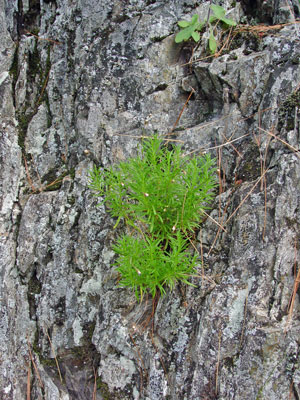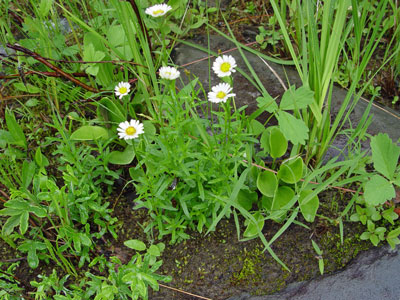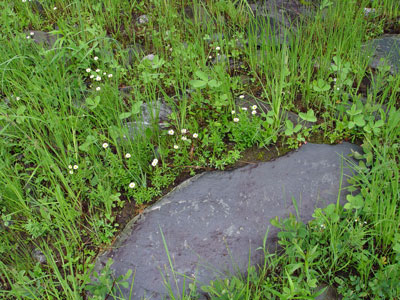DACF Home → Bureaus & Programs → Maine Natural Areas Program → Communities, Plants, and Animals → Rare Plants → Erigeron hyssopifolius

Erigeron hyssopifolius Michx.
Hyssop-leaved Fleabane
- State Rank: S2
- Global Rank: G5
- State Status: Special Concern
Habitat: Calcareous rocks, talus and gravels. [Non-tidal rivershore (non-forested, seasonally wet); Rocky summits and outcrops (non-forested, upland)]
Range: Newfoundland to Mackenzie, south to New Brunswick and northern New England, and west to Michigan.
Aids to Identification: A low (up to 20 cm) herbaceous plant growing in tufts. The leaves are very narrow (linear), about 2-3 cm long, alternate on the stem, and both stem and leaves are hairless or nearly so. The stems often bear axillary tufts. The flower-heads generally resemble the common fleabanes, E. strigosus (daisy-like); they are up to 2 cm broad, with 15-30 white or purplish rays. Another aster-like plant, Ionactis linariifolius, can grow in the same habitat: it has rigid leaves and lacks axillary tufts of leaves. The other rare fleabane in Maine, Erigeron acris var. kamtschatica or bitter fleabane, is taller (3-8 dm).

Ecological characteristics: A perennial, growing from slender rootstocks directly out of rock crevices. In Maine, it grows only along some rivershores in the northern half of the state. Where habitat is suitable, the plants are often abundant. Competition from other plants appears to be limited, possibly because of the severity of the habitat, which is subjected to annual ice scouring and flooding.
Phenology: In Maine , begins flowering in early July. Fruits often remain on plant through August.
Family: Asteraceae
Synonyms: Amazingly, this Asteraceae plant has not had any name changes!

Known Distribution in Maine: This rare plant has been documented from a total of 19 town(s) in the following county(ies): Aroostook, Penobscot, Piscataquis, Somerset.
Reason(s) for rarity: At southern limit of range; natural scarcity of calcareous substrate in Maine.
Conservation considerations: Unknown; little current information on this species. Its habitat appears subject to little threat except for recreational use, which in the past has not been heavy where it grows.